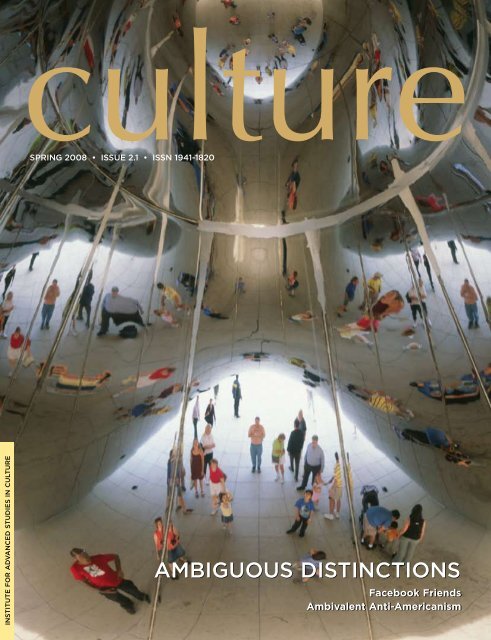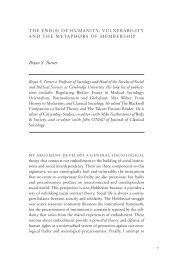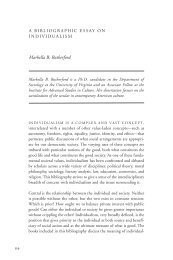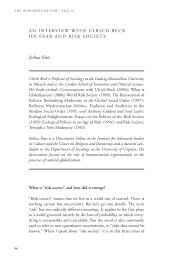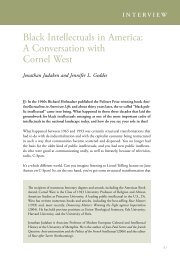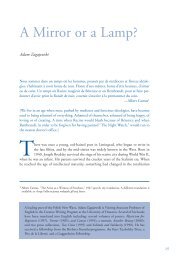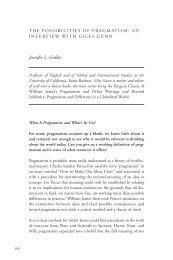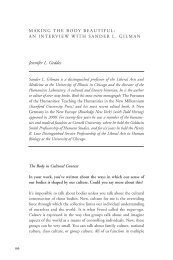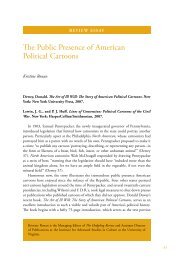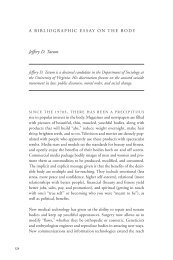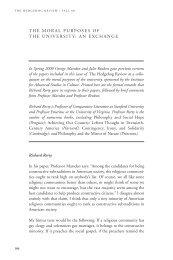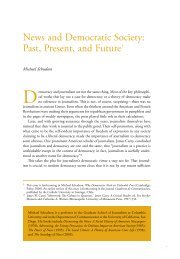ambiguous distinctions - Institute for Advanced Studies in Culture
ambiguous distinctions - Institute for Advanced Studies in Culture
ambiguous distinctions - Institute for Advanced Studies in Culture
You also want an ePaper? Increase the reach of your titles
YUMPU automatically turns print PDFs into web optimized ePapers that Google loves.
culture
p<br />
p <br />
<br />
p
culture<br />
Joseph E. Davis<br />
Krist<strong>in</strong>e Harmon<br />
Emily Raudenbush<br />
Branner Graphic Design<br />
<br />
<br />
<br />
<br />
<br />
<br />
<br />
<br />
<br />
<br />
<br />
<br />
<br />
2<br />
5<br />
<br />
Mirrors of contemporary <strong>in</strong>dividualism<br />
<br />
The ironies of exported culture<br />
<br />
12 <br />
An <strong>in</strong>terview with IASC Fellow Shannon Anderson<br />
16 <br />
A short <strong>in</strong>terview with Allan Megill<br />
<br />
<br />
<br />
<br />
<br />
<br />
8<br />
<br />
A judicious read<strong>in</strong>g of secularity and religion<br />
14 <br />
By Richard Sennett<br />
<br />
15 <br />
<br />
<br />
<br />
<br />
<br />
17
Mirrors of contemporary <strong>in</strong>dividualism<br />
Felicia Wu Song
to the lives of teenagers<br />
or college students knows that be<strong>in</strong>g on MySpace or Facebook<br />
is almost essential to their everyday experience. MySpace and<br />
Facebook are social-network<strong>in</strong>g sites on the Internet that are<br />
part-yearbook, part-Rolodex, part-Little Black Book, and partanswer<strong>in</strong>g<br />
mach<strong>in</strong>e, with the advantage of be<strong>in</strong>g perpetually<br />
updated—by the second. They allow users to publicly develop<br />
and display their social connections and exchange messages<br />
with<strong>in</strong> larger, overlapp<strong>in</strong>g, and <strong>in</strong>tersect<strong>in</strong>g networks. Many<br />
college students admit to be<strong>in</strong>g “addicted” to Facebook and<br />
leave the site permanently open on their computers. They<br />
check it right after they roll out of bed <strong>in</strong> the morn<strong>in</strong>g, while<br />
they study, and even <strong>in</strong> the middle of lectures on wireless<br />
campuses.<br />
The sudden ubiquity of social-network<strong>in</strong>g sites has left some<br />
parents of teenagers feel<strong>in</strong>g worried and helpless. These virtual<br />
hangouts seem beyond parental control and adult surveillance.<br />
While the broader impact of social-network<strong>in</strong>g sites is yet to<br />
be seen, it is possible that their significance will be short-lived.<br />
Facebook and MySpace could fizzle out and w<strong>in</strong>d up as another<br />
of the “has-beens” among the short-term bus<strong>in</strong>ess failures of<br />
the Internet. However, there are good reasons to believe that<br />
social-network<strong>in</strong>g sites are here to stay. They neatly “fit” key<br />
cultural realities of contemporary life <strong>in</strong> ways that few <strong>in</strong>stitutions<br />
do.<br />
Consider the social-network<strong>in</strong>g practice of “friend<strong>in</strong>g.” Users<br />
who jo<strong>in</strong> a social-network<strong>in</strong>g site create personal profiles<br />
where they can express their <strong>in</strong>terests and values. Users then<br />
browse the site, <strong>in</strong>vit<strong>in</strong>g others to their Friends list, and <strong>in</strong><br />
the process ga<strong>in</strong> access to their Friends’ networks of personal<br />
profiles as well. On a daily basis, users update their profiles,<br />
check <strong>for</strong> new <strong>in</strong><strong>for</strong>mation on their Friends’ profiles, and send<br />
messages to each other. Given the time <strong>in</strong>volved <strong>in</strong> generat<strong>in</strong>g<br />
all this social <strong>in</strong><strong>for</strong>mation, it is not surpris<strong>in</strong>g that the most<br />
faithful and active users of social-network<strong>in</strong>g sites are teenagers<br />
and college students.<br />
While Friends lists often <strong>in</strong>clude actual friends from users’<br />
lives, be<strong>in</strong>g a “Friend” <strong>in</strong> a social-network<strong>in</strong>g site does not<br />
necessarily <strong>in</strong>dicate a mean<strong>in</strong>gful relationship. In fact, the<br />
value of a Friend connection is often merely symbolic and <strong>in</strong><br />
many cases, relationally negligible. With a click of a button,<br />
one can just as easily add Hollywood celebrities, <strong>in</strong>die bands,<br />
or presidential candidates to one’s Friends list as one might
add a roommate, girlfriend, or cous<strong>in</strong>. While most<br />
observers marvel over the relational cornucopia that<br />
these sites create, what is more strik<strong>in</strong>g is the fact<br />
that celebrities, rock stars, and one’s social <strong>in</strong>timates<br />
can exist side-by-side on a Friends list with little or<br />
no dissonance. A banality of friendship is designed<br />
<strong>in</strong>to the functions of these sites. Its easy acceptance<br />
suggests that young Americans are both amenable to<br />
a “th<strong>in</strong>n<strong>in</strong>g out” of personal relationships and a “thicken<strong>in</strong>g” of<br />
ties to public figures conventionally encountered through the<br />
mass media. In this way, Friends lists publicly articulate and<br />
re<strong>in</strong><strong>for</strong>ce the contemporary experience of “pseudo-community,”<br />
the illusion of relationship that media audiences feel with<br />
television talk-show hosts, movie stars, and other celebrities.<br />
The success of social-network<strong>in</strong>g sites also suggests that young<br />
Americans are com<strong>for</strong>table approach<strong>in</strong>g their personal relationships<br />
<strong>in</strong> the mode of consumer. Facebook’s “News Feed”<br />
feature, <strong>for</strong> example, keeps users up-to-date on each of their<br />
Friends’ onl<strong>in</strong>e behaviors: who has posted on whose page,<br />
who has removed whom from their Friends list, and who has<br />
jo<strong>in</strong>ed which group. Users can even keep track of the status<br />
of their Friends’ chang<strong>in</strong>g romantic relationships. The options<br />
<strong>in</strong>clude “s<strong>in</strong>gle,” “<strong>in</strong> a relationship,” “engaged,” “married,” or (my<br />
personal favorite) “it’s complicated.” With celebrities and close<br />
friends occupy<strong>in</strong>g the same social space, the daily practice of<br />
“keep<strong>in</strong>g up” with one’s Friends’ profiles shares a disconcert<strong>in</strong>g<br />
similarity with “keep<strong>in</strong>g up” with the news on MSNBC<br />
or a Yahoo! page. As the ma<strong>in</strong>tenance of social relationships<br />
becomes primarily a <strong>for</strong>m of <strong>in</strong><strong>for</strong>mation management, friendships<br />
easily shade <strong>in</strong>to a <strong>for</strong>m of consumption. Individuals, <strong>in</strong><br />
turn, update their profiles and “produce” their identities onl<strong>in</strong>e<br />
<strong>for</strong> the express purpose of be<strong>in</strong>g consumed <strong>in</strong> this fashion. As<br />
with many other contemporary social practices, where the<br />
private and public blur together, the value of <strong>in</strong>timacy decl<strong>in</strong>es<br />
and the consumer role is amplified.<br />
F<strong>in</strong>ally, social-network<strong>in</strong>g sites may have last<strong>in</strong>g consequence<br />
because their very design articulates what sociologist Barry<br />
Wellman has long argued: the local community is no longer<br />
a mean<strong>in</strong>gful category <strong>for</strong> many Americans. While we are<br />
clearly embodied be<strong>in</strong>gs, the salience of physical location has<br />
dim<strong>in</strong>ished <strong>in</strong> how contemporary Americans th<strong>in</strong>k about and<br />
function <strong>in</strong> their social lives. The best way to describe contemporary<br />
sociability is <strong>in</strong> terms of “networked <strong>in</strong>dividualism,”<br />
overlapp<strong>in</strong>g networks of social ties that have <strong>in</strong>dividuals at the<br />
The success of social-network<strong>in</strong>g sites<br />
also suggests that young Americans are<br />
com<strong>for</strong>table approach<strong>in</strong>g their personal<br />
relationships <strong>in</strong> the mode of consumer.<br />
core of each. People understand “community” <strong>in</strong> terms of multiple<br />
systems of friends, contacts, and acqua<strong>in</strong>tances that span<br />
time and place—but are oriented around each <strong>in</strong>dependent<br />
self. Uses of other technologies, such as cell phones, re<strong>in</strong><strong>for</strong>ce<br />
this dynamic. People make more and more calls not to places<br />
or households, but to <strong>in</strong>dividuals, quite apart from their physical<br />
location.<br />
In Sources of the Self, the philosopher Charles Taylor meticulously<br />
documents the trans<strong>for</strong>mation of personal identity<br />
<strong>in</strong> Western civilization over the past two hundred years. He<br />
argues that the sources of self-identity have shifted from<br />
external and transcendent referents to the <strong>in</strong>ternal and subjective<br />
experience of the <strong>in</strong>dividual. Other scholars, like Robert<br />
Putnam and Adam Seligman, make similar arguments about<br />
the decl<strong>in</strong>e of community as an orient<strong>in</strong>g feature of people’s<br />
lives. That many operate as though the sources of personal<br />
identity are with<strong>in</strong> the <strong>in</strong>dividual self is strongly suggested by<br />
the popularity and easy adoption of social-network<strong>in</strong>g sites.<br />
There, networks radiate out from the center—a center that is<br />
not a location, a cause, or a common identity, but simply the<br />
<strong>in</strong>dividual. Sites operate on the presupposition that users are<br />
com<strong>for</strong>table orient<strong>in</strong>g their social lives around themselves.<br />
And so, it seems, they are, as young Americans easily recast<br />
pre-exist<strong>in</strong>g relationships and practices of sociability accord<strong>in</strong>g<br />
to site prerequisites. While the cultural changes that make this<br />
adaptability possible have been long <strong>in</strong> the mak<strong>in</strong>g, it may be<br />
that as late-modern <strong>in</strong>dividuals, we have f<strong>in</strong>ally begun to create<br />
social <strong>in</strong>stitutions that reflect and re<strong>in</strong><strong>for</strong>ce basic dispositions<br />
towards networked <strong>in</strong>dividualism and consumption <strong>in</strong> the <strong>in</strong>timate<br />
sphere. What is so remarkable about social-network<strong>in</strong>g<br />
sites is not, then, how much they change the landscape of<br />
contemporary social life, but rather how well they succeed <strong>in</strong><br />
reflect<strong>in</strong>g its essential dynamic.
Ambivalent<br />
Anti-Americanism<br />
The ironies of exported culture<br />
James L. Nolan, Jr.<br />
represent one of the most<br />
<strong>in</strong>terest<strong>in</strong>g and important <strong>in</strong>novations <strong>in</strong> the contemporary<br />
legal world. Over the past two decades, community courts,<br />
drug courts, mental health courts, domestic violence courts,<br />
and a range of other specialty, problem-oriented courts have<br />
been developed <strong>in</strong> the United States and exported <strong>in</strong>ternationally.<br />
These new specialty courts (of which there are now more<br />
than 1,600 <strong>in</strong> the U.S. alone) represent a significant departure<br />
from the adversarial model, which has long been the central<br />
and def<strong>in</strong><strong>in</strong>g feature of common law crim<strong>in</strong>al courts. Problemsolv<strong>in</strong>g<br />
courts are generally characterized (especially <strong>in</strong> the<br />
United States) by the close and ongo<strong>in</strong>g judicial monitor<strong>in</strong>g of<br />
defendants, a multidiscipl<strong>in</strong>ary or team-oriented approach, a<br />
therapeutic or treatment orientation, the alter<strong>in</strong>g of traditional<br />
roles <strong>in</strong> the adjudication process, and an emphasis on solv<strong>in</strong>g<br />
the problems of <strong>in</strong>dividual offenders—hence, the umbrella<br />
term, “problem-solv<strong>in</strong>g,” that has emerged to describe this new<br />
breed of courts.<br />
At a 1999 conference <strong>in</strong> Miami a group of <strong>in</strong>dividuals <strong>in</strong>volved<br />
<strong>in</strong> the <strong>in</strong>ternational development of problem-solv<strong>in</strong>g courts—<br />
<strong>in</strong>clud<strong>in</strong>g representatives from Canada, Scotland, Australia,
England, Ireland, and the United States—discussed, among<br />
other topics, concerns about “American cultural imperialism.”<br />
The Scottish representative, who had been promot<strong>in</strong>g<br />
drug courts <strong>in</strong> Scotland <strong>for</strong> three years, offered the follow<strong>in</strong>g<br />
anecdote to illustrate the anti-American attitudes that had<br />
sometimes frustrated his promotional ef<strong>for</strong>ts:<br />
I was meet<strong>in</strong>g with a director of social work, who has<br />
responsibility <strong>for</strong> the probation service and the second<br />
largest authority <strong>in</strong> Scotland. He says, “I’ll meet<br />
you <strong>in</strong> Starbucks down <strong>in</strong> Glasgow,” and he came <strong>in</strong><br />
with these Nike tra<strong>in</strong>ers and his Levi’s jeans and the<br />
rest of the American designer gear, and he said to<br />
me, “Of course, American ideas just don’t work <strong>in</strong><br />
Brita<strong>in</strong>.”<br />
The irony of the Scottish social worker denounc<strong>in</strong>g American<br />
ideas while at the same time fully embrac<strong>in</strong>g American products<br />
is <strong>in</strong>dicative of a larger social reality. That is, globally one<br />
f<strong>in</strong>ds a k<strong>in</strong>d of ambivalent anti-Americanism, where citizens<br />
<strong>in</strong> other countries say they don’t like American ideas and<br />
the <strong>in</strong>cessant <strong>in</strong>fusion of American culture <strong>in</strong>to their societies,<br />
yet they simultaneously admire and readily consume<br />
American technology and cultural products. British journalist<br />
Jonathan Freedland notes the “scream<strong>in</strong>g contradiction”<br />
of attitudes toward the U.S. “We simultaneously disda<strong>in</strong> and<br />
covet American culture,” Freedland writes, “condemn<strong>in</strong>g it<br />
as junk food even as we reach <strong>for</strong> another help<strong>in</strong>g—a k<strong>in</strong>d of<br />
b<strong>in</strong>ge-and-puke social bulimia.”<br />
One of the most <strong>in</strong>terest<strong>in</strong>g f<strong>in</strong>d<strong>in</strong>gs <strong>in</strong> the Global Attitudes<br />
Project conducted by the Pew Research Center reveals a similar<br />
sort of ambivalence toward the U.S. globally. The Project’s<br />
2002 survey of citizens <strong>in</strong> over 40 countries around the world<br />
found that Americanization, or the spread of “American ideas<br />
and customs,” is overwhelm<strong>in</strong>gly viewed as a negative development.<br />
Not surpris<strong>in</strong>gly, this is particularly pronounced <strong>in</strong><br />
the Middle East, where a majority <strong>in</strong> every Middle Eastern<br />
country says “it’s bad that American ideas and customs are<br />
spread<strong>in</strong>g” to their country. Concerns about the processes of<br />
Americanization, however, are not limited to the Middle East.<br />
Even among America’s traditional allies <strong>in</strong> Western Europe and<br />
Canada, at least 50 percent of those surveyed <strong>in</strong> each national<br />
group viewed negatively the spread of American ideas and<br />
customs.<br />
S<strong>in</strong>ce the 2002 survey, such concerns have only <strong>in</strong>tensified.<br />
The 2007 Pew Global Attitudes survey reported that <strong>in</strong> 37 of<br />
46 countries over half of those surveyed viewed the processes<br />
of Americanization as a bad th<strong>in</strong>g. Negative views about the<br />
spread of American ideas and customs, <strong>for</strong> example, <strong>in</strong>creased<br />
<strong>in</strong> Canada from 54 percent <strong>in</strong> 2002 to 67 percent <strong>in</strong> 2007 and<br />
<strong>in</strong> Brita<strong>in</strong> from 50 to 67 percent. Survey f<strong>in</strong>d<strong>in</strong>gs reveal grow<strong>in</strong>g<br />
anti-Americanism on a range of other questions as well.<br />
The 2007 survey, <strong>for</strong> example, found that majorities <strong>in</strong> all but a<br />
handful of African countries believe that U.S. policies <strong>in</strong>crease<br />
the gap between rich and poor countries. Majorities <strong>in</strong> most<br />
countries, moreover, dislike American ideas about democracy<br />
and believe that the U.S. promotes democracy to serve its<br />
own <strong>in</strong>terests. Thus, it seems that many would agree with the<br />
perspective of the Scottish social worker that American ideas<br />
don’t work (or are not welcomed) <strong>in</strong> their country.<br />
Also like the Scottish social worker, however, negative views<br />
about the spread of American ideas and customs do not<br />
necessarily translate <strong>in</strong>to a rejection of American cultural<br />
products. The same surveys f<strong>in</strong>d that a majority of people <strong>in</strong><br />
most countries around the world admire the United States<br />
<strong>for</strong> its advances <strong>in</strong> science and technology and like American<br />
popular culture. This is particularly the case <strong>in</strong> Canada and<br />
Western Europe. In the 2002 survey, <strong>for</strong> example, 77 percent of<br />
Canadian and 76 percent of British respondents said they “like<br />
American music, television, and movies”; and approximately<br />
the same percentages said they “admire the United States <strong>for</strong> its<br />
technological and scientific advances.” Thus, the survey report<br />
offers the follow<strong>in</strong>g paradoxical conclusion: while “large proportions<br />
<strong>in</strong> most countries th<strong>in</strong>k it is bad that American ideas<br />
and customs are spread<strong>in</strong>g to their countries,” there is also<br />
“near universal admiration <strong>for</strong> U.S. technology and a strong<br />
appetite <strong>for</strong> its cultural exports <strong>in</strong> most parts of the world.” In<br />
a number of <strong>in</strong>terest<strong>in</strong>g ways, importers of American problemsolv<strong>in</strong>g<br />
courts exhibit the same contradictory attitudes toward<br />
the United States. That is, they worry about American cultural<br />
imperialism, even while they import and embrace what is<br />
undeniably an American-grown legal <strong>in</strong>novation.<br />
The primary way that importers of American problem-solv<strong>in</strong>g<br />
courts reconcile these seem<strong>in</strong>gly <strong>in</strong>congruous attitudes is<br />
to emphasize the process of adaptation or <strong>in</strong>digenization.<br />
An Irish judge, who has himself been openly critical of the<br />
behavior of many American judges, puts it this way: “In the<br />
natural order of th<strong>in</strong>gs, you tailor the program to what suits<br />
you best. Not because you th<strong>in</strong>k there’s anyth<strong>in</strong>g wrong with<br />
the American system—but all you’re say<strong>in</strong>g is, we’re three
thousand miles away from you, we have a different culture, etc.<br />
And we’ve just got to tailor that, put up the cuffs, and make<br />
the suit fit us.” Likewise, a pioneer<strong>in</strong>g Canadian judge, who is<br />
very conscious of anti-American sentiments <strong>in</strong> Canada, told an<br />
audience of mostly Americans: “We want to use what you’ve<br />
done well, ignore what you haven’t done so well, and adapt the<br />
model <strong>in</strong>to our own local use.”<br />
are consum<strong>in</strong>g whole chunks of American values ‘<strong>in</strong>, with,<br />
and under’ the American hamburgers.” The same could be<br />
said of problem-solv<strong>in</strong>g courts. It is as naive to believe that a<br />
process of domestication will fully extricate Americanism from<br />
imported problem-solv<strong>in</strong>g courts as it is to th<strong>in</strong>k that plac<strong>in</strong>g a<br />
McDonald’s restaurant <strong>in</strong> an old Tudor build<strong>in</strong>g will somehow<br />
negate the unseemly qualities of American fast food culture.<br />
There is, then, the common belief that the American-grown<br />
legal product can be stripped of its unattractive American<br />
qualities and adapted to suit the needs of a local legal culture.<br />
If we understand law to be “a concentrated expression of the<br />
history, culture, social values and the general consciousness<br />
and perception of a given people,” as do such legal comparativists<br />
as Mary Ann Glendon, then disentangl<strong>in</strong>g law from its<br />
cultural roots may not be as easy as importers of problemsolv<strong>in</strong>g<br />
courts seem to th<strong>in</strong>k. Peter Berger raises a related po<strong>in</strong>t<br />
when he argues that when “Mexicans eat hamburguesas they<br />
In both cases, importers of American products are arguably<br />
br<strong>in</strong>g<strong>in</strong>g on board more of American culture than they realize<br />
or would care to admit. A deeper appreciation of the cultural<br />
embeddedness of American-grown products, legal and otherwise,<br />
might help importers reduce the ambivalence <strong>in</strong> their<br />
attitudes toward the U.S.—urg<strong>in</strong>g them either to better resist<br />
the very th<strong>in</strong>gs they say they so emphatically dislike or perhaps<br />
to admit that they dislike them less than they are usually will<strong>in</strong>g<br />
to acknowledge.
Book reviewed <strong>in</strong> this essay:<br />
<br />
<br />
<br />
<br />
<br />
A judicious read<strong>in</strong>g of secularity and religion<br />
Slavica Jakelić<br />
was one of the<br />
most significant events of the late twentieth century. The<br />
potency and global character of religious revival was widely<br />
discussed, and compelled scholars and politicians traditionally<br />
dismissive of religion to start pay<strong>in</strong>g attention. Then, just<br />
when the collapse of communism portended the end of radical<br />
atheism and even the most fervent advocates of secularization<br />
theory were reth<strong>in</strong>k<strong>in</strong>g their position, secularism and atheism<br />
re-emerged on the public stage.<br />
Over the past few years, books both critical of religion and<br />
explicitly antireligious have become overnight best-sellers,<br />
<strong>in</strong>clud<strong>in</strong>g Sam Harris’s The End of Faith, Daniel Dennett’s<br />
Break<strong>in</strong>g the Spell, Richard Dawk<strong>in</strong>s’s The God Delusion, and<br />
Christopher Hitchens’s God Is not Great. Hitchens, particularly,<br />
contends that the popularity of everyth<strong>in</strong>g secular happened<br />
because people got fed up with everyth<strong>in</strong>g religious. The<br />
renaissance of secularism <strong>in</strong> an <strong>in</strong>creas<strong>in</strong>gly religious world,<br />
Hitchens, like many others, argues, is the result of a power<br />
struggle between religious and secular worldviews.<br />
This argument is not without foundation. In the world of<br />
politics, secular elites from the U.S. to France, from Turkey to<br />
India, are <strong>in</strong> fact confront<strong>in</strong>g the rise and sometimes hostile<br />
demands of public religions. A power struggle argument is also<br />
appeal<strong>in</strong>g because it is simple, cogent, and precise. But is it too<br />
simple? Must the relationship between religion and secularism<br />
be characterized by animosity and confrontation?<br />
To address this question critically, we need non-ideological<br />
books that offer judicious read<strong>in</strong>gs of the mean<strong>in</strong>g of secularity<br />
and its relationship to various <strong>for</strong>ms of religion and modernity.<br />
Fortunately, these books exist and <strong>in</strong>clude Talal Asad’s The<br />
Formations of the Secular, Jacques Berl<strong>in</strong>erblau’s The Secular<br />
Bible, and Oliver Roy’s Secularism Confronts Islam. Add to<br />
this list Charles Taylor’s 800-page tour de <strong>for</strong>ce, A Secular Age.<br />
It is <strong>in</strong>dispensable <strong>for</strong> appreciat<strong>in</strong>g the relationship between<br />
secularity and religion <strong>in</strong> the West.<br />
At first glance, the book appears a reiteration of an old sociological<br />
story—how modernity enabled the very possibility of
and historical developments <strong>in</strong> the rise of Western modernity<br />
and the growth of secularity. At the heart of both, he argues,<br />
is a “drive to Re<strong>for</strong>m.” Contrary to what might be expected,<br />
Taylor does not see this drive beg<strong>in</strong>n<strong>in</strong>g with the Protestant<br />
Re<strong>for</strong>mation, though he does see the Re<strong>for</strong>mation as the most<br />
radical religious expression of it. Rather, he locates the drive<br />
to Re<strong>for</strong>m <strong>in</strong> the late medieval period, orig<strong>in</strong>at<strong>in</strong>g <strong>in</strong> a deep<br />
discontent “with the hierarchical equilibrium between lay life<br />
and the renunciative vocations.” In response to this discontent,<br />
the church translated the norms of religious life <strong>for</strong> application<br />
to lay believers <strong>in</strong> order to draw the laity closer to the life of<br />
religious elites.<br />
Although profoundly embedded <strong>in</strong> the theological and historical<br />
developments of Western Christianity, the un<strong>in</strong>tended and<br />
gradual consequences of the drive to Re<strong>for</strong>m were radically<br />
secular. Shap<strong>in</strong>g the view that what human be<strong>in</strong>gs owe to God<br />
is the achievement of their own good, the drive to Re<strong>for</strong>m contributed<br />
to the fad<strong>in</strong>g of the sense of mystery. It <strong>in</strong>augurated a<br />
vision of human agency as able to construct and reconstruct<br />
the world, a belief that each human be<strong>in</strong>g can work on herself<br />
to achieve a good life and collectively shape a good society. The<br />
drive to Re<strong>for</strong>m was, one could say, a process of the democratization<br />
of virtue and, above all, it embodied confidence <strong>in</strong> the<br />
ability of human be<strong>in</strong>gs to create conditions of human flourish<strong>in</strong>g:<br />
freedom, mutual welfare, and equality.<br />
unbelief and the pluralism of worldviews. Taylor asks: how did<br />
we, <strong>in</strong> the West, lose the enchanted world of our ancestors and<br />
arrive at a condition <strong>in</strong> which, even when we believe, we are<br />
“never, or only rarely, really sure, free of all doubt, untroubled<br />
by some objection”? Not much seems to be novel <strong>in</strong> this l<strong>in</strong>e<br />
of <strong>in</strong>quiry, especially to those acqua<strong>in</strong>ted with Peter Berger’s<br />
notion of the “heretical imperative.” But Taylor moves beyond<br />
the usual explanations of the path to secular society, which<br />
po<strong>in</strong>t to the effects of the scientific revolution, Renaissance<br />
humanism, the rise of the “police state,” or the Re<strong>for</strong>mation. He<br />
is concerned to illum<strong>in</strong>ate the moral sources of a secular age.<br />
In his characteristically patient and charitable manner of narration,<br />
Taylor traces key philosophical, theological, sociological,<br />
The drive to Re<strong>for</strong>m fostered a gradual movement from<br />
transcendence to immanence. It created a “disenchanted<br />
world” where<strong>in</strong> secular humanism was possible and religious<br />
faith, while still turned toward the transcendent, <strong>in</strong>creas<strong>in</strong>gly<br />
focused on the prosperity of human k<strong>in</strong>d. The trans<strong>for</strong>mation<br />
Taylor documents is nicely captured <strong>in</strong> the change that<br />
occurred with<strong>in</strong> the Roman Catholic Church between the<br />
papal documents Syllabus of Errors and Rerum Novarum. With<br />
these two documents, published <strong>in</strong> the span of four decades <strong>in</strong><br />
the n<strong>in</strong>eteenth century, the Catholic Church moved from condemn<strong>in</strong>g<br />
everyth<strong>in</strong>g modern to encourag<strong>in</strong>g the lay faithful to<br />
actively participate <strong>in</strong> the modern world.<br />
In Taylor’s rich, multilayered, and sometimes too pedantic<br />
account of the moral orig<strong>in</strong>s of contemporary beliefs and<br />
unbeliefs, the novelty of his claims can be easily overlooked. He<br />
not only suggests that a secular age does not imply the death<br />
of God; he also says that it makes a wide range of beliefs and<br />
unbeliefs exist simultaneously without negat<strong>in</strong>g each other. He
does more than rem<strong>in</strong>d us that the orig<strong>in</strong>s of secular humanism<br />
are <strong>in</strong> Western Christendom; he also tells us that the only<br />
way to counter “the immense <strong>for</strong>ce of religion <strong>in</strong> human life”<br />
is to use “a modality of the most powerful ethical ideas, which<br />
this religion itself ha[s] helped to entrench.” Most importantly,<br />
Taylor shows that both modern Western Christianity and<br />
modern Western secularity were shaped by the same moral<br />
drive—the impulse to re<strong>for</strong>m <strong>in</strong>dividuals so that they might<br />
apply themselves to creat<strong>in</strong>g a better world.<br />
Accord<strong>in</strong>g to Taylor, the moral sources embodied <strong>in</strong> the drive<br />
to Re<strong>for</strong>m cont<strong>in</strong>ue to animate contemporary religious faiths<br />
and <strong>for</strong>ms of secular humanism. To retrieve them, I would<br />
argue, is particularly pert<strong>in</strong>ent <strong>for</strong> our world, <strong>in</strong> which the only<br />
modus operandi between secularisms and religions appears to<br />
many to be conflict. To be sure, the differences between secular<br />
humanism and religion are immense, especially <strong>in</strong> their view<br />
of the source of ultimate authority. For the secular humanists,<br />
authority is <strong>in</strong> each one of us; <strong>for</strong> religious people, it belongs <strong>in</strong><br />
the realm of transcendence. To complicate th<strong>in</strong>gs further, there<br />
are various <strong>for</strong>ms of secular humanism and they greatly differ<br />
among themselves. And, of course, religion comes <strong>in</strong> many<br />
modes and expressions.<br />
The seriousness of these differences notwithstand<strong>in</strong>g, the<br />
shared moral sources of secular humanism and religion <strong>in</strong><br />
the West (and arguably beyond) must not be ignored. When<br />
attended to and drawn upon, they can have remarkable <strong>in</strong>fluence.<br />
Some leaders of the Catholic Church and the political<br />
Left <strong>in</strong> Poland seemed to have understood this <strong>in</strong> the last<br />
decades of the twentieth century, when they worked together<br />
aga<strong>in</strong>st the communist regime and <strong>for</strong> democracy. Viewed<br />
with<strong>in</strong> the framework of power relations, their agreement<br />
appears to be merely a pragmatic compromise to fight a common<br />
enemy. But, as the writ<strong>in</strong>gs of Polish religious and secular<br />
elites show, theirs was also a moral consensus—about the dignity<br />
of the human person and the nature of a good society. A<br />
Secular Age sets the recent Polish experience <strong>in</strong> an even larger<br />
and deeper moral context. One may hope it does not rema<strong>in</strong><br />
an exception.
An <strong>in</strong>terview with IASC Fellow Shannon Anderson<br />
Shannon Anderson’s dissertation, titled<br />
Assimilation and the Mean<strong>in</strong>g of America,<br />
1915–2005, explores contested ideas about<br />
American national identity over the past century.<br />
Her <strong>in</strong>vestigation centers on three key<br />
moments when immigration was a prom<strong>in</strong>ent political issue. We<br />
live <strong>in</strong> one of those moments.<br />
<br />
<br />
<br />
<br />
The crisis <strong>in</strong> which we f<strong>in</strong>d ourselves today is not an unfamiliar<br />
one <strong>in</strong> American history. Perhaps the most comparable<br />
period <strong>in</strong> the past century, <strong>in</strong> terms of heightened nativist<br />
rhetoric and public discourse about cultural diversity, was the<br />
period immediately preced<strong>in</strong>g and follow<strong>in</strong>g the First World<br />
War. In both moments, the United States found itself tak<strong>in</strong>g<br />
<strong>in</strong> huge numbers of immigrants dur<strong>in</strong>g a time of ris<strong>in</strong>g and<br />
then fully consummated <strong>in</strong>ternational <strong>in</strong>stability. The common<br />
conditions, then and now, are high levels of immigration and<br />
<strong>in</strong>volvement <strong>in</strong> a <strong>for</strong>eign war.<br />
What I would suggest is that <strong>in</strong>stead of accept<strong>in</strong>g the<br />
language of public debate, we shift our th<strong>in</strong>k<strong>in</strong>g <strong>in</strong> such a way<br />
as to address what is really at stake. While there are certa<strong>in</strong>ly<br />
concrete economic and social issues to consider, <strong>in</strong>clud<strong>in</strong>g<br />
illegal immigration, when Americans express deep concerns<br />
about immigration, the more compell<strong>in</strong>g matter is often quite<br />
different. Their concern is with the mean<strong>in</strong>g of America itself.<br />
People—the man on the street, politicians, scholars, pundits—<br />
feel their sense of national selfhood to be <strong>in</strong> flux, or even<br />
threatened. This is not true of everyone, of course, but it is <strong>for</strong><br />
many. What I would argue is that crises regard<strong>in</strong>g immigration<br />
are usually crises of identity, and <strong>in</strong> the American story, these<br />
can perhaps be best understood as crises of assimilation.<br />
<br />
<br />
Identity is most <strong>in</strong>tensely a question when it is <strong>in</strong> confrontation<br />
with an “other.” So, <strong>for</strong> example, <strong>in</strong> the current immigration<br />
crisis, it is no surprise that many of the loudest and least<br />
sympathetic voices concern<strong>in</strong>g new immigrants come from<br />
the southwestern states where the impact of the newcomers<br />
is most palpable. Americans liv<strong>in</strong>g <strong>in</strong> the states that border<br />
Mexico—the country from which the largest number of immigrants<br />
arrive—see, feel, and are affected by immigration more<br />
directly than the rest of us. They often make stronger claims<br />
about what is dist<strong>in</strong>ctive <strong>in</strong> be<strong>in</strong>g an American because, <strong>in</strong><br />
part, they see different cultural values and customs <strong>in</strong> operation<br />
that can challenge or appear to challenge the values and<br />
traditions they hold dear.<br />
This challenge of the “other” is only heightened dur<strong>in</strong>g a<br />
period of hostile engagement with other countries. The fervor<br />
of flag-fly<strong>in</strong>g and national emotion follow<strong>in</strong>g the September<br />
11, 2001 terrorist attacks was a concentrated expression of this<br />
dynamic. Our very way of life appears threatened; the response<br />
is a far more <strong>for</strong>ceful assertion of who we are as Americans<br />
than is normally felt to be necessary. It should be emphasized,<br />
though, that there are compet<strong>in</strong>g imag<strong>in</strong><strong>in</strong>gs of America, and<br />
so compet<strong>in</strong>g narratives of who “we” are.<br />
<br />
First, there is the story of an Anglo-Saxon America that draws<br />
upon the critical role that English ideas, customs, and people<br />
have had <strong>in</strong> the U.S. Those who see America <strong>in</strong> this way tend<br />
to emphasize the strength and success of this particular <strong>in</strong>heritance<br />
<strong>for</strong> American <strong>in</strong>stitutions and ideologies, and worry<br />
about its dilution through high levels of immigration. This<br />
story was told by early sociologists like E. A. Ross <strong>in</strong> the 1910s<br />
<strong>in</strong> response to the <strong>in</strong>flux of Southern and Eastern Europeans,<br />
and is still told—though with a new emphasis on Lat<strong>in</strong>o, and
especially Mexican immigration—by scholars like Samuel<br />
Hunt<strong>in</strong>gton today.<br />
There are two additional and familiar stories of America<br />
that offer alternatives to the more <strong>in</strong>sular Americanist one.<br />
The story of America as a melt<strong>in</strong>g pot, one of the more potent<br />
images <strong>in</strong> narratives of the nation, emphasizes the <strong>in</strong>stitutional<br />
power of the U.S. to embrace a vast diversity of newcomers and<br />
create someth<strong>in</strong>g bigger, better, and stronger than be<strong>for</strong>e. Israel<br />
Zangwill, the British playwright who gave us this metaphor <strong>in</strong><br />
his 1908 play, The Melt<strong>in</strong>g Pot, offered the most radical version<br />
of this story. He suggested that all Americans are part of and<br />
affected by the mix<strong>in</strong>g, and would be culturally trans<strong>for</strong>med<br />
<strong>in</strong>to a “new race” as immigrants enter and change the blend.<br />
This is the most future-oriented of American stories, <strong>in</strong> that<br />
there is an implicit recognition of ongo<strong>in</strong>g change. Cultural<br />
pluralism, and later multiculturalism, offers the third dom<strong>in</strong>ant<br />
story. In this imag<strong>in</strong><strong>in</strong>g, first put <strong>for</strong>ward by Horace Kallen<br />
<strong>in</strong> 1915, America is a unified political state but is culturally a<br />
nation of nations (or ethnicities); the entry of new cultures is<br />
to be celebrated and all ethnic groups who have or will immigrate<br />
here are to be recognized and valued, with no one group<br />
ma<strong>in</strong>ta<strong>in</strong><strong>in</strong>g itself as dom<strong>in</strong>ant.<br />
<br />
<br />
<br />
These stories are told by elites of various k<strong>in</strong>ds and filter<br />
down <strong>in</strong>to the textbooks, but it seems to me unlikely that<br />
most Americans consciously put themselves <strong>in</strong>to one of these<br />
specific groups. Still, given the predom<strong>in</strong>ance of these three<br />
stories over at least the past century, they certa<strong>in</strong>ly <strong>in</strong>fluence<br />
the way peoples’ views on immigration break down. At the<br />
current moment, the degree of anxiety expressed by so many<br />
Americans about immigration suggests that people may be<br />
consider<strong>in</strong>g these issues more explicitly than is usual. There is<br />
a polarized way <strong>in</strong> which immigration is discussed on television<br />
and the <strong>in</strong>ternet media, and the effect may be to virtually<br />
exclude the idea of the melt<strong>in</strong>g pot. Americans are seem<strong>in</strong>gly<br />
<strong>for</strong>ced to choose either “conservative” anti-immigration rhetoric<br />
or “progressive” multicultural rhetoric. My sense of these<br />
th<strong>in</strong>gs is that, as is the case regard<strong>in</strong>g so many issues, vast<br />
numbers of Americans fall <strong>in</strong> the middle, which might look<br />
very much like Zangwill’s story, or like one of less antagonistic<br />
<strong>in</strong>tegration.
Book Review<br />
The <strong>Culture</strong> of the New<br />
Capitalism<br />
<br />
<br />
<br />
In The <strong>Culture</strong> of the New Capitalism,<br />
Richard Sennett teases out the mean<strong>in</strong>g<br />
of the new economy and its attendant<br />
ideals <strong>for</strong> ord<strong>in</strong>ary men and women.<br />
He is not enamored of what he f<strong>in</strong>ds.<br />
Sennett, a public <strong>in</strong>tellectual who splits<br />
his time between professorships <strong>in</strong> sociology<br />
at M.I.T. and the London School of<br />
Economics, is especially <strong>in</strong>terested <strong>in</strong> how<br />
we can cont<strong>in</strong>ue to f<strong>in</strong>d dignity, create a<br />
sense of self, and build an <strong>in</strong>clusive polity<br />
<strong>in</strong> the midst of an economic order that<br />
makes such pursuits exceed<strong>in</strong>gly difficult.<br />
At the heart of the book is the<br />
connection between two dom<strong>in</strong>ant economic<br />
models and the k<strong>in</strong>ds of people<br />
and societies that these models demand.<br />
Though organizations run accord<strong>in</strong>g to<br />
these models rarely employ a majority of<br />
any society’s members, the models exert<br />
a profound moral and normative <strong>for</strong>ce<br />
because they are widely believed to be<br />
<strong>in</strong>augurat<strong>in</strong>g the future.<br />
Bismarck conceived the old <strong>in</strong>dustrial<br />
economic model <strong>in</strong> the late n<strong>in</strong>eteenth<br />
century; bus<strong>in</strong>esses and governments<br />
throughout the <strong>in</strong>dustrial world implemented<br />
it <strong>in</strong> the twentieth. This “social<br />
capitalism” was built <strong>for</strong> stability and<br />
<strong>in</strong>clusion of the masses—to prevent revolution<br />
if <strong>for</strong> no more lofty goal. This<br />
was society as a pyramid, with lots of<br />
room at the base. If some workers found<br />
such a corporation to be a psychologically<br />
cramped “iron cage,” as Max Weber<br />
put it, this cage had benefits. Pr<strong>in</strong>cipally,<br />
this economic order made long-term<br />
plann<strong>in</strong>g and stability possible and so<br />
facilitated the creation of social relationships<br />
and life-narratives that ground the<br />
self <strong>in</strong> usefulness to others.<br />
Economic changes <strong>in</strong> the 1970s,<br />
<strong>in</strong>clud<strong>in</strong>g the collapse of the Bretton<br />
Woods monetary system and the emergence<br />
of efficient automation, have<br />
gradually replaced this old culture with<br />
a new model. Impatient shareholders<br />
<strong>in</strong>creas<strong>in</strong>gly demand flexibility of corporations—the<br />
ability to change course<br />
<strong>in</strong> turbulent markets. Cutt<strong>in</strong>g-edge corporations,<br />
<strong>in</strong> turn, demand flexibility of<br />
their workers, not loyalty over the long<br />
term. Creativity and the ability to work<br />
well on short-term projects have become<br />
sought-after virtues <strong>in</strong> the new economy.<br />
These corporations trade <strong>in</strong> potential.<br />
With potential as a key <strong>in</strong>gredient of success,<br />
hard-won experience at a s<strong>in</strong>gle job<br />
has become a liability, even a personal<br />
failure. Without the old pyramid structure<br />
underp<strong>in</strong>n<strong>in</strong>g an <strong>in</strong>clusive social<br />
politics, a “spectre of uselessness” now<br />
hangs on those judged to be without<br />
talent. For Sennett, these are traumatic<br />
cultural shifts. Only a certa<strong>in</strong> k<strong>in</strong>d of<br />
person can thrive <strong>in</strong> such a culture, one<br />
who is will<strong>in</strong>g to do without a susta<strong>in</strong>ed<br />
life-narrative, who privileges potential<br />
skills over past accomplishment, and<br />
who is will<strong>in</strong>g to surrender experience<br />
<strong>in</strong> order to embrace an uncerta<strong>in</strong> future.<br />
Such a person, as Sennett puts it, “is an<br />
unusual human be<strong>in</strong>g.”<br />
Sennett spends the last chapter<br />
offer<strong>in</strong>g values that might countervail<br />
this new and more flexible culture and<br />
its spectre of uselessness. Among other<br />
partial fixes, he recommends job shar<strong>in</strong>g<br />
to elim<strong>in</strong>ate <strong>in</strong>security and state assistance<br />
to those who care without pay <strong>for</strong><br />
elderly relatives or children. Here, as <strong>in</strong><br />
the rest of the text, Sennett is eloquent<br />
and persuasive, if more controversial.<br />
His deep research <strong>in</strong>to the sociology<br />
of work grounds the argument and his<br />
prescriptive conclusions. At first look,<br />
one might compla<strong>in</strong> that his description<br />
of the old economy takes too nostalgic a<br />
cast. After all, the old economic system<br />
Sennett describes is hardly a world that<br />
C. Wright Mills or other mid-century<br />
critics would have recognized. But this<br />
disjuncture more likely lies <strong>in</strong> the difference<br />
between 1951, when Mills called<br />
middle-class workers of the old order<br />
<strong>in</strong>ternally “fragmented,” and the early<br />
twenty-first century, when <strong>in</strong> retrospect<br />
the self demanded by that white-collar<br />
world can seem relatively whole. <br />
—Scott Nesbit
In the News<br />
<br />
<br />
Charles Mathewes, IASC Faculty Fellow<br />
and author of A Theology of Public Life,<br />
will moderate a panel at the Virg<strong>in</strong>ia<br />
Festival of the Book on “The Politics<br />
of God: The Faith Factor <strong>in</strong> American<br />
Public Life and Why We Can’t Stop<br />
Talk<strong>in</strong>g about Religion.” Authors<br />
Charles Marsh and Amy Sullivan will<br />
be discuss<strong>in</strong>g their new books on the<br />
topic. The festival runs March 26–30.<br />
Look <strong>for</strong> details <strong>in</strong> the IASC eNewsletter<br />
or onl<strong>in</strong>e at www.vabook.org. <br />
Don’t miss a s<strong>in</strong>gle event!<br />
<br />
At Brown University <strong>in</strong> December,<br />
<strong>Institute</strong> Executive Director <br />
debated Morris<br />
Fior<strong>in</strong>a of Stan<strong>for</strong>d on the question, “Is<br />
America <strong>in</strong> the midst of a culture war?”<br />
C-SPAN covered the event…Former<br />
Postdoctoral Fellow has<br />
jo<strong>in</strong>ed the Department of History at<br />
Furman University. Her dissertation,<br />
“The Mean<strong>in</strong>g of Death and the Mak<strong>in</strong>g<br />
of Three Berl<strong>in</strong>s: A History, 1933–1961,”<br />
has received the Fritz Stern Prize, given<br />
annually by the German Historical<br />
<strong>Institute</strong> <strong>for</strong> the two best dissertations<br />
<strong>in</strong> the field of German history…<br />
Cambridge University Press published<br />
’s latest book, A<br />
Theology of Public Life, <strong>in</strong> September<br />
as part of the Cambridge <strong>Studies</strong> <strong>in</strong><br />
Christian Doctr<strong>in</strong>e series…Senior<br />
Fellow received<br />
an honorary doctorate from The Free<br />
University of Amsterdam on October<br />
19, 2007…Faculty Fellow <br />
received a Virg<strong>in</strong>ia Foundation<br />
<strong>for</strong> the Humanities Fellowship <strong>for</strong> Fall<br />
2007 to f<strong>in</strong>ish his book, The Ethos of<br />
a Late-Modern Citizen…In December,<br />
Director completed<br />
her term as Co-Chair of the Arts,<br />
Literature, and Religion section of the<br />
American Academy of Religion. <br />
<br />
<br />
<br />
<br />
<br />
The God of a Second Chance, the<br />
<strong>Institute</strong>-sponsored film directed by<br />
Paul Wagner, won the Best Feature<br />
Length Documentary award at the<br />
“Our City Film Festival” <strong>in</strong> Wash<strong>in</strong>gton,<br />
D.C. on February 10, 2008. The festival<br />
is sponsored by Yachad, Inc., the Jewish<br />
Hous<strong>in</strong>g and Community Development<br />
Corporation of Greater Wash<strong>in</strong>gton. <br />
THE HEDGEHOG REVIEW<br />
CRITICAL REFLECTIONS ON CONTEMPORARY CULTURE<br />
F<strong>in</strong>d out what everyone’s read<strong>in</strong>g...<br />
2008 Subscriptions Now Available<br />
Utopia, Dystopia, and the Future<br />
The Media and Politics<br />
Citizenship<br />
$25/1 year or $45/2 years<br />
www.virg<strong>in</strong>ia.edu/iasc/hedgehog.html<br />
(434)243-8935 / hedgehog@virg<strong>in</strong>ia.edu
This year, a small group of fellows,<br />
staff, and directors of the <strong>Institute</strong> have<br />
been meet<strong>in</strong>g monthly to discuss issues<br />
of race and human flourish<strong>in</strong>g. The<br />
aim of the group is to consider one of<br />
the most important and vex<strong>in</strong>g issues<br />
of the modern era—race—<strong>in</strong> its relation<br />
to some of the central questions<br />
of the <strong>Institute</strong>—concern<strong>in</strong>g what it<br />
means to be human, the order<strong>in</strong>g of<br />
our communal and public life, and the<br />
conditions of contemporary life that<br />
<strong>in</strong>hibit or enhance the possibilities <strong>for</strong><br />
a good life.<br />
This year the group has <strong>in</strong>vited:<br />
On January 25th, <br />
gave a lecture on “Human Flourish<strong>in</strong>g<br />
<strong>in</strong> W. E. B. DuBois’ (Late) Sociological<br />
Imag<strong>in</strong>ation.” Dr. Bryant is Assistant<br />
Professor of Sociology<br />
at the College of<br />
the Holy Cross. His<br />
lecture was co-sponsored<br />
by the Special<br />
Lectures Committee and the Carter G.<br />
Woodson <strong>Institute</strong> <strong>for</strong> Afro-American<br />
and African <strong>Studies</strong>.<br />
On February 28th, <br />
, Associate Professor of<br />
History and Director of the Marcus W.<br />
Orr Center <strong>for</strong> the Humanities at the<br />
University of Memphis, will speak. <br />
Allan Megill on Objectivity<br />
The <strong>Institute</strong>’s Friday Sem<strong>in</strong>ar has been concerned with reductionism and<br />
scientism. On February 1, Allan Megill, Professor of History at UVa, led a<br />
sem<strong>in</strong>ar on the question of objectivity and the writ<strong>in</strong>g of history. Professor<br />
Megill is the author of Historical Knowledge, Historical Error (Chicago<br />
University Press, 2007) and has written extensively on objectivity. We asked<br />
him to reflect on a couple of the many issues at stake.<br />
<br />
<br />
No, it doesn’t, because there are other <strong>for</strong>ms of objectivity. For example,<br />
there is a procedural or methodological type of objectivity. Procedural<br />
objectivity <strong>in</strong>volves follow<strong>in</strong>g time-tested epistemological rules. Some<br />
rules are general, such as the rule that we ought to take account not just of<br />
evidence that supports our favored position, but also of evidence that contradicts<br />
it. This amounts to say<strong>in</strong>g that we scholars ought to be judges, not<br />
prosecutors or defense attorneys or propagandists <strong>for</strong> a favored cause. Other<br />
rules are peculiar to specific types of <strong>in</strong>quiry. For example, two important<br />
rules <strong>in</strong> historical research are the rule that primary testimony is better than<br />
second-hand testimony, and the rule that testimony of either k<strong>in</strong>d is more<br />
credible when it is supported by material evidence. Procedure is not a route<br />
to absolute truth; it does offer a way of arriv<strong>in</strong>g at a “good enough” truth,<br />
which may well be the most one can hope <strong>for</strong> at any given moment.<br />
<br />
<br />
By “reduction to agenda” I mean an unreflective tendency to promote one<br />
favored paradigm, or mode of research, <strong>in</strong> one’s field. For example, history<br />
has seen a competition <strong>in</strong> the last twenty years between the social history<br />
and the new cultural history paradigms, with the latter now dom<strong>in</strong>ant.<br />
But while the new cultural history has produced <strong>in</strong>terest<strong>in</strong>g work, it has<br />
also brought about some important exclusions. Too often the costs are<br />
not attended to. Potentially important work is pushed to the marg<strong>in</strong>s—or<br />
never written at all. Scholars need to learn to push aga<strong>in</strong>st the dom<strong>in</strong>ant<br />
paradigms. They can only do this by cultivat<strong>in</strong>g a curiosity and range of<br />
learn<strong>in</strong>g that go beyond what “everyone knows” <strong>in</strong> their discipl<strong>in</strong>e. Often,<br />
“everyone” does not know.
The Last Word<br />
<br />
Joseph E. Davis<br />
Moral order is a central dimension of<br />
culture. Generally, the term refers to<br />
any system of obligations that def<strong>in</strong>es<br />
and organizes the proper—good, right,<br />
virtuous—relations among <strong>in</strong>dividuals<br />
and groups <strong>in</strong> a community. Such systems<br />
derive from religions, traditions<br />
(Romantic <strong>in</strong>dividualism, natural law<br />
theory, etc.), or ideologies. They are<br />
expressed explicitly <strong>in</strong> <strong>in</strong>stitutional rules,<br />
laws, moral codes, and the like, as well as<br />
implicitly <strong>in</strong> the various roles, rites, and<br />
rituals of social life. Complex societies<br />
like the United States <strong>in</strong>volve compet<strong>in</strong>g<br />
and amalgamated moral orders.<br />
This understand<strong>in</strong>g of moral order<br />
is useful as far as it goes, but it can also<br />
be somewhat mislead<strong>in</strong>g. It tends to<br />
draw our attention to moral rules and<br />
normative expectations and away from<br />
a more fundamental level on which<br />
features of the world are ordered and<br />
<strong>in</strong>fused with moral significance. Moral<br />
order is also present <strong>in</strong> the very conceptualiz<strong>in</strong>g<br />
and structur<strong>in</strong>g of reality.<br />
Illum<strong>in</strong>at<strong>in</strong>g moral order at this level<br />
was the life-long project of the British<br />
social anthropologist Mary Douglas.<br />
She conceived of order as how we assign<br />
and keep th<strong>in</strong>gs <strong>in</strong> their “place,” and<br />
her work explored how we react when<br />
th<strong>in</strong>gs get out of place.<br />
Douglas’s work began with and<br />
extended the <strong>in</strong>sights of Émile Durkheim,<br />
the early French sociologist. Tribal<br />
societies, Durkheim showed, are held<br />
together by shared categories of thought<br />
and social demarcation. These societies<br />
provide the classification systems—<strong>in</strong>clud<strong>in</strong>g<br />
categories of time, space, and<br />
causality—and the metaphors that guide<br />
their members and make collective<br />
action possible. In modern societies,<br />
however, this common symbolic life is<br />
ruptured. Now, Durkheim argued, unity<br />
flows from an <strong>in</strong>terdependence created<br />
by the complex division of labor, and<br />
some truths, especially those of science,<br />
are not social but “express the world as<br />
it is.” Mary Douglas rejected this sharp<br />
dist<strong>in</strong>ction between primitive and modern<br />
societies, and its social exemption<br />
of modern <strong>in</strong>tellectual achievements. “It<br />
is easier to see that tribesmen project<br />
the moral order upon their universe,”<br />
she wrote <strong>in</strong> Implicit Mean<strong>in</strong>gs, “than<br />
to recognize the same process work<strong>in</strong>g<br />
among ourselves.” For Douglas, shared<br />
classifications constitute a central and<br />
<strong>in</strong>escapable dimension of order <strong>in</strong> all<br />
human societies. Mak<strong>in</strong>g <strong>dist<strong>in</strong>ctions</strong><br />
through socially provided categories,<br />
k<strong>in</strong>ds, and def<strong>in</strong>itions is how we trans<strong>for</strong>m<br />
unorganized needs and experience<br />
<strong>in</strong>to mean<strong>in</strong>gful <strong>for</strong>ms. It is how we<br />
know, <strong>for</strong> <strong>in</strong>stance, what it is permissible<br />
to eat, where, at what times, and<br />
with whom.<br />
Our classifications, however, are not<br />
arbitrary nor are they merely questions<br />
of “the world as it is.” Accepted classifications,<br />
Douglas emphasized, draw<br />
the l<strong>in</strong>es of the world; they def<strong>in</strong>e what<br />
is real, what is natural, what is right and<br />
just. Th<strong>in</strong>gs have a place and they belong<br />
<strong>in</strong> that place. The moral dimension to<br />
this sort<strong>in</strong>g and boundary draw<strong>in</strong>g is<br />
most evident when objects, behaviors,<br />
or ideas are out of place—when they<br />
“blur, smudge, contradict, or otherwise<br />
confuse accepted classifications.” Some<br />
(not all) of this “out of place” is dirt,<br />
defilement, deviance: our response is<br />
to condemn it and to enact rituals—as<br />
simple as wash<strong>in</strong>g one’s hands—that reestablish<br />
the proper order.<br />
Douglas’s conception of moral<br />
order, then, goes deeper than beliefs<br />
about mutual obligation. And it contradicts<br />
the commonplace classification of<br />
doma<strong>in</strong>s of life <strong>in</strong>to those that are valueladen<br />
(religion, family life, poetry) and<br />
those that are “neutral” or value-free<br />
(the liberal state, science, the capitalist<br />
market). She shows us that we too project<br />
a moral order upon our universe and<br />
actively work to defend and uphold it.<br />
Dame Mary Douglas died <strong>in</strong> May<br />
2007. She was 86.
Recent Books<br />
<br />
<br />
<br />
<br />
<br />
<br />
<br />
<br />
<br />
<br />
<br />
<br />
<br />
<br />
The Rights of God:<br />
Islam, Human Rights, and<br />
Comparative Ethics<br />
<br />
<br />
<br />
Promot<strong>in</strong>g Islam as a<br />
defender of human<br />
rights is laden with<br />
difficulties. Advocates<br />
of human rights will<br />
readily po<strong>in</strong>t out<br />
numerous humanitarian<br />
failures carried out <strong>in</strong> the name of<br />
Islam. Professor Oh exam<strong>in</strong>es human<br />
rights and Islam as a religious issue<br />
rather than a political or legal one and<br />
draws on three revered Islamic scholars<br />
to offer a broad range of perspectives<br />
that challenge our assumptions about<br />
the role of religion <strong>in</strong> human rights.<br />
Irene Oh is Assistant Professor of<br />
Religious <strong>Studies</strong> at the University of<br />
Miami and a <strong>for</strong>mer dissertation fellow<br />
of the Center on Religion and Democracy<br />
at the <strong>Institute</strong>.<br />
The Politics of Secularism<br />
<strong>in</strong> International Relations<br />
<br />
<br />
<br />
Conflicts <strong>in</strong>volv<strong>in</strong>g religion<br />
have returned to<br />
the <strong>for</strong>efront of <strong>in</strong>ternational<br />
relations, yet<br />
scholars have cont<strong>in</strong>ued<br />
to assume that<br />
religion has long been<br />
privatized <strong>in</strong> the West. Professor Hurd<br />
argues that secularist divisions between<br />
religion and politics are not fixed, but<br />
socially and historically constructed.<br />
She develops a new approach to religion<br />
and <strong>in</strong>ternational relations that<br />
challenges the presid<strong>in</strong>g assumptions<br />
<strong>in</strong> this field.<br />
Elizabeth Shakman Hurd is Assistant<br />
Professor of Political Science at<br />
Northwestern University and a <strong>for</strong>mer<br />
postdoctoral fellow of the Center on<br />
Religion and Democracy at the <strong>Institute</strong>.<br />
culture


